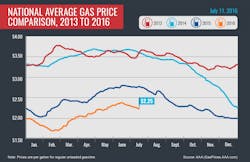Gas Prices Extend Slide To 30 Days
Pump prices have now fallen for 30 straight days—the longest streak since August/September of last year—and are at their lowest mark for this date since 2004. Today’s national average price for regular unleaded gasoline is $2.23 per gallon, which is four cents per gallon less than a week ago, fifteen cents less than a month ago and 53 cents less than one year ago. Prices for some drivers are even lower with some 25,000 gas stations (approximately a quarter of stations) nationwide now selling gasoline for less than $2.00.
Gasoline prices are poised to continue their slide this week as both crude oil and wholesale gasoline prices turned lower last week. West Texas Intermediate and Brent crude were each down more than 7% last week, with WTI, the primary U.S. benchmark, falling from $48.99 to $45.41 (-7.9%) over the course of the holiday-shortened trading week. The price of oil currently reflects slightly more than half the price of gasoline at the pump, so lower oil prices are expected to result in lower retail gas prices for drivers. Additionally, the most recent Department of Energy report cited domestic gasoline production as just 100,000 barrels per day short of the all-time record, lending further momentum to falling prices.
While retail gas prices may continue to slide through the month of July, there are a number of factors that could cause prices to rise again. This includes an increase in the global price of crude oil due to disruption in supply, stronger than expected economic indicators or geopolitical tensions overseas; as well as domestic factors like refinery issues, production cuts due to lower prices, stronger than anticipated demand or hurricanes that impact distribution and production.
Quick Stats
- The West Coast remains the most expensive region to by gasoline in the country, led by California ($2.88), Hawaii ($2.83), Washington ($2.67), Alaska ($2.66) and Nevada ($2.57).
- The nation’s least expensive markets are South Carolina ($1.93), Oklahoma ($2.00) Mississippi ($2.00), Missouri ($2.01) and Alabama ($2.02).
West Coast
As is often the case drivers on the West Coast continue to pay the most expensive gas prices in the nation; however, these same motorists are also experiencing the most substantial yearly savings at the pump. Each of the top-five largest year-over-year savings is in this region: Alaska (-81 cents), California (-71 cents), Nevada (-67 cents), Utah (-64 cents) and Oregon (-61 cents). While West Coast drivers are benefiting from these lofty discounts, these motorists are all too familiar with the impact of refinery glitches that could quickly reverse this trend. While gasoline supplies in the region remain comfortable, the Department of Energy did report a decline of 400,000 barrels to 27.9 million for the week ending July 1, in part credited to motorists filling their tanks in advance of travel for the July 4 holiday weekend. Regional production also increased during this same period, although not enough to offset the higher demand.
Rockies
Gas prices for motorists in the Rocky Mountain region have been among the most stable in the nation as supply and demand have kept prices largely in balance. This includes four states in the region among the top-five most stable over the past month: Wyoming (down fractions of a penny), Idaho (-1 cent), New Mexico (-1 cent) and Arizona (+2 cents).
Great Lakes and Central States
Drivers in the Great Lakes Region have been no stranger to dramatic fluctuations in the price they pay at the pump as regional refinery and distribution issues have regularly sent prices sharply higher only to drop again once the issue has been resolved. The past month has been no different and four states in the region top the list of largest declines: Ohio (-60 cents), Michigan (-50 cents), Indiana (-49 cents) and Illinois (-35 cents). While declines in Central States have not been as pronounced, they are still substantial with Missouri (-20 cents) and Tennessee (-17 cents) both ranking in the top-ten and Oklahoma (-16 cents) just missing the cut at number 11.
Mid-Atlantic and Northeast
Pump prices in the Mid-Atlantic and Northeast have also seen prices fall over the past month, although the discounts registered have been substantially less severe than those in the Great Lakes region. Limiting some of the retail price decline in the region have been reports that refineries supplying the region are reducing production in the face of narrow profit margins. Lower production would be expected to exert some upward pressure on prices, although to date it has not been enough to offset the combined downward pressure from lower oil prices and few unexpected refinery issues.
Gulf Coast and Southeast
Drivers in the southeastern quadrant of the U.S. continue to enjoy some of the cheapest prices in the nation, due to the advantageous proximity to major Gulf Coast refineries and some of the lowest state gasoline taxes in the country. Five states in the region rank in the top-ten lowest prices nationwide: South Carolina ($1.93), Mississippi ($2.00), Alabama ($2.02), Arkansas ($2.02) and Louisiana ($2.05).
Oil Market Dynamics
Global oil prices have continued to sag thanks largely to indications of increased supply. This includes reports that June production by the Organization of Petroleum Exporting Countries rose to more than 32.5 million barrels per day, as Nigerian production ramped up following disruptions. While these reports have pressured global prices lower, the region remains volatile and an incident that impacts production or heightens geopolitical concerns could send prices higher again. At the close of Friday’s formal trading session on the NYMEX, WTI was up 27 cents to settle at $45.41 per barrel.
